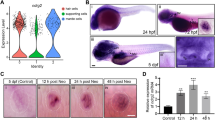Abstract
Although mammals are notoriously poor at regeneration compared with many lower-order species, the hair follicle, particular to mammals, is capable of regeneration following partial amputation. The detailed internal mechanism of this phenomenon is still unclear. Development and regrowth of the hair follicle depends on dermal-epidermal interaction within the hair follicle. Previous studies have shown that Wnt/β-catenin, Shh, Bmp, PDGF, TGF and Notch signals all take part in the development and growth of the hair follicle, and the Wnt/β-catenin signaling additionally plays an indispensable role in hair follicle morphogenesis and regrowth. In this study, we investigated the localization, as well as, protein levels of Wnt/β-catenin signaling molecules during amputated whisker follicle regeneration.




Similar content being viewed by others
Abbreviations
- DP:
-
Dermal papilla
- DS:
-
Dermal sheath
- HS:
-
Hair shaft
- IRS:
-
Inner root sheath
- Mx:
-
Matrix
- ORS:
-
Outer root sheath
References
Andl T, Reddy ST et al (2002) WNT signals are required for the initiation of hair follicle development. Dev Cell 2(5):643–653
Fang DR, Lv ZF et al (2014) Dynamic Wnt5a expression in murine hair follicle cycle and its inhibitory effects on follicular. Asian Pac J Trop Med 7(4):285–288
Gurtner GC, Werner S et al (2008) Wound repair and regeneration. Nature 453(7193):314–321
Iida M, Ihara S et al (2007) Follicular epithelia and dermal papillae of mouse vibrissal follicles qualitatively change their hair-forming ability during anagen. Differentiation 75(5):371–381
Jahoda CA, Horne KA et al (1992) Cellular and extracellular involvement in the regeneration of the rat lower vibrissa follicle. Development 114(4):887–897
Kobayashi K, Nishimura E (1989) Ectopic growth of mouse whiskers from implanted lengths of plucked vibrissa follicles. J Invest Dermatol 92(2):278–282
Kwack MH, Kim MK et al (2012) Dickkopf 1 promotes regression of hair follicles. J Invest Dermatol 132(6):1554–1560
Larouche D, Tong X et al (2008) Vibrissa hair bulge houses two populations of skin epithelial stem cells distinct by their keratin profile. FASEB J 22(5):1404–1415
Lavker RM, Sun TT (2000) Epidermal stem cells: properties, markers, and location. Proc Natl Acad Sci U S A 97(25):13473–13475
Li YH, Zhang K et al (2011) Wnt10b promotes growth of hair follicles via a canonical Wnt signalling pathway. Clin Exp Dermatol 36(5):534–540
Li YH, Zhang K et al (2013) Adenovirus-mediated Wnt10b overexpression induces hair follicle regeneration. J Invest Dermatol 133(1):42–48
Lin CM, Yuan YP et al. (2015) Expression of Wnt/beta-catenin signaling, stem-cell markers and proliferating cell markers in rat whisker hair follicles. J Mol Histol
Millar SE (2002) Molecular mechanisms regulating hair follicle development. J Investig Dermatol 118(2):216–225
Oliver RF (1991) Dermal-epidermal interactions and hair growth. J Invest Dermatol 96(5):76S
Plikus MV (2014) At the dawn of hair research—testing the limits of hair follicle regeneration. Exp Dermatol
Poblet E, Jimenez F (2003) CD34 in human hair follicle. J Invest Dermatol 121(5):1220 author reply 1220-1221
Poblet E, Jimenez F (2008) CD10 and CD34 in fetal and adult human hair follicles: dynamic changes in their immunohistochemical expression during embryogenesis and hair cycling. Br J Dermatol 159(3):646–652
Poblet E, Jimenez F et al (2006) The immunohistochemical expression of CD34 in human hair follicles: a comparative study with the bulge marker CK15. Clin Exp Dermatol 31(6):807–812
Reddy S, Andl T et al (2001) Characterization of Wnt gene expression in developing and postnatal hair follicles and identification of Wnt5a as a target of Sonic hedgehog in hair follicle morphogenesis. Mech Dev 107(1–2):69–82
Stenn KS, Paus R (2001) Controls of hair follicle cycling. Physiol Rev 81(1):449–494
Sun G, Irvine KD (2014) Control of growth during regeneration. Curr Top Dev Biol 108:95–120
Sun TT, Cotsarelis G et al (1991) Hair follicular stem cells: the bulge-activation hypothesis. J Invest Dermatol 96(5):77S–78S
Wang HD, Yang L et al (2012) Immunolocalization of beta-catenin and Lef-1 during postnatal hair follicle development in mice. Acta Histochem 114(8):773–778
Waters JM, Cowin AJ (2013) Lower vibrissa follicle amputation: a mammalian model of regeneration. Methods Mol Biol 1037:437–448
Xing Y, Xu W et al (2011) Immunolocalization of Wnt5a during the hair cycle and its role in hair shaft growth in mice. Acta Histochem 113(6):608–612
Xing YZ, Wang RM et al (2013) Adenovirus-mediated wnt5a expression inhibits the telogen-to-anagen transition of hair follicles in mice. Int J Med Sci 10(7):908–914
Young RD, Oliver RF (1976) Morphological changes associated with the growth cycle of vibrissal follicles in the rat. J Embryol Exp Morphol 36(3):597–607
Acknowledgments
This work was supported by grants from the National Science Foundation of China (Nos. 81372084, 81171832) and Guangdong Province Outstanding Young Teacher Training Program (No. Yq2013078) and Guangdong Scientific Research Funding Program (No. 2014A020211024). Dr. Stanley Lin is very appreciated for editing the language for this paper.
Author information
Authors and Affiliations
Corresponding author
Additional information
Yan-Ping Yuan and Keng Huang have contributed equally to this work.
Rights and permissions
About this article
Cite this article
Yuan, YP., Huang, K., Xu, YM. et al. Canonical and non-canonical Wnt signaling control the regeneration of amputated rodent vibrissae follicles. J Mol Hist 47, 1–8 (2016). https://doi.org/10.1007/s10735-015-9648-x
Received:
Accepted:
Published:
Issue Date:
DOI: https://doi.org/10.1007/s10735-015-9648-x




